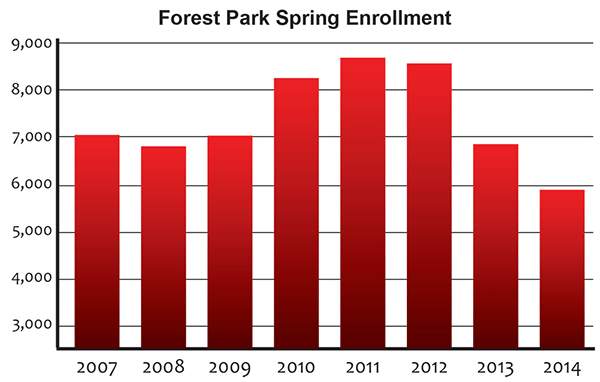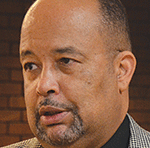
By Brian Ruth
The Scene staff
The trend of declining enrollment continues at Forest Park, with spring figures down 15 percent from a year ago, from 6,888 to 5,888 students, according to the latest data published by the college.
Forest Park Bookstore cashier Erica Coleman, 34, said she noticed “bigger crowds” last fall compared to this semester. In fall of 2013, enrollment was at 6,815.
Coleman, a general transfer student, also sees the impact of the trend in her classes.
“You might start out with 30 or 40 kids,” she said. “Now, it’s half that.”
Vice President of Student Affairs Thomas Walker said ups and downs in enrollment figures aren’t unusual at community colleges.
“It could be any number of things, and I wouldn’t put my finger on any single one of them,” he said.
According to Walker, “more people getting jobs and stricter financial-aid accountability” are two reasons that enrollment could be declining.
Districtwide, Forest Park’s loss was the highest of the four campuses this semester, but it remains the second highest in enrollment.
Meramec has the highest enrollment, with 8,985 students, down 594 from a year ago. Florissant Valley had a spring enrollment of 5,442 this year, losing 607 students. The Wildwood campus lost only 50 students, but has the lowest enrollment at 1,377.

Walker noted that one of Forest Park’s major sources of students – the St. Louis public school system — is shrinking. It has been experiencing “smaller graduating classes for years,” he said.
Fewer incoming students creates more competition among colleges, Walker said, and that can contribute to lower enrollments.
Associate humanities professor Mark Kruger said Forest Park enrollment is gradually returning to pre-recession levels.
The financial crisis of 2008 led to a slowdown of job growth in the United States, while enrollment at Forest Park spiked. Overall, the economy has been slow to recover.
“As the recession starts to ease, people will go back to work,” Kruger said.
Spring enrollments at Forest Park during the recession peaked in 2011, with 8,698 students.
“We saw a steady increase, no matter which semester it was,” said President Cindy Hess, noting there was a reversal in traditionally lower spring enrollments during the recession.
The spring enrollment of 2013 was similar to the last pre-recession spring enrollment — 7,035 in 2007.
Whatever the reasons, lower enrollment means fewer available classes, creating tough choices for students.
Many factors that cause enrollment declines can’t be controlled. What administrators can control, Walker said, is doing a better job on the instructional side, especially in skills development classes.
“Much of our attrition comes from developmental education,” he said.
Hess and Walker agree that the transition from developmental to college-level courses can be difficult for adults returning to school.
“We’re doing a total redesign of our developmental studies courses,” Hess said, “because that’s an area where we lose students.”
Another potential contributor to lower enrollments that administrators can control is the registration process.
The recent remodeling of the Student Center to ease registration hassles allows Student Affairs staffers “to make the process more seamless,” Walker said.
Walker also understands the benefit that improved online services can have for busy students. Information technology services need to be “more robust,” he said.
“Reminding students to take advantage of priority registration and to check their Degree Audit Reports is crucial to graduating on time,” Hess said.
